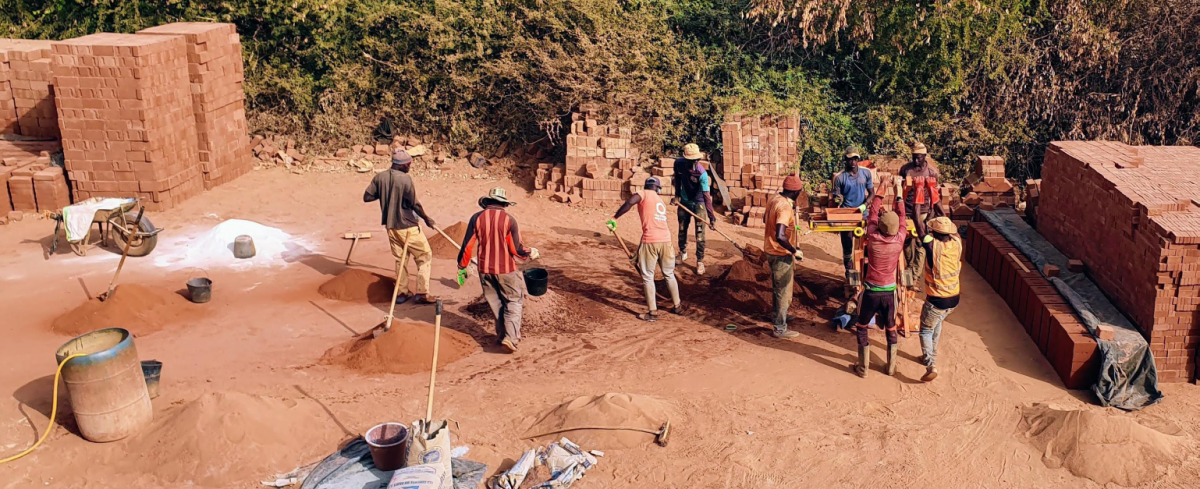Cementless, 100% locally made blocks for energy efficient housing
The biggest obstacle in scaling Compressed Earth Blocks for housing is the price and environmental effect of cement which needs to be used as a binder. 5-7% of the block is cement, responsible for 50% of the price. TNO and her partners OSKAM and LEVS succeeded to find alternative binders, fully obtained from local resources in Senegal. These Cementless Compact Earth Blocks have great potential as business, environmental footprint and social impact.

What are Cementless Compact Earth Blocks?
Compressed earth blocks are uniform building blocks, compressed from clay-retaining earth mixed with cement as binder. The compressed earth blocks are not fired and not hollow so that they have a unique low CO2 footprint. Today the biggest obstacle is the price and environmental effect of cement which needs to be used as a binder: 5-7% of material, but 50% of the price. TNO and her partners OSKAM and LEVS succeeded to find alternative binders, fully obtained from local resources in Senegal. This Cementless Compact Earth Blocks, which would only require local resources and no cement, have great potential because the price of blocks will drop substantially as well as its environmental footprint and envisioned social impact.
Alternative binders
The survey of local resources in Senegal confirmed that sufficient local and cheap (waste) resources are available to make a 100% local Cementless Compressed Earth Block as our preliminary tests on 8 local resource types (5 of which are waste streams) showed a promising match with the physico-chemical properties required. Four of the 8 resources are a candidate to replace cement and perform as a soluble component in a cementless binder without prior heat treatment. The other four resources are a candidate to replace cement after a prior heat treatment (calcination) at temperatures lower than 1000 °C. Three of the eight can - next to form a binder - also be used in a coarser form as the skeleton that fills up the largest part of the compressed block and which is held together by the binder. All of the resources are (environmentally) safe and 6 of the 8 are available in large enough quantities without compromising other industries.
Successful feasibility study in Senegal

Our efforts have delivered a promising technical and economic feasibility and a concept for a compact machine able to produce Cementless Compact Earth Block including the selection and establishment of the most suitable local partners and potential customers in Senegal, a concept of the business case based on the local resources survey and required machinery, a selection of the most suitable local resources to be used for block manufacturing, and the definition of the tests to be performed with those resources in order to produce and qualify the new blocks. This project was financially supported by Netherlands Enterprise Agency as part of the program Small Business Innovation Research on Circular Economy.
Next stage approved
Also the second stage of this promising project received financial support. Activities will consist amongst other of optimization of the recipe for optimum resource efficiency, minimizing the need for calcination while maintaining or even improving (long term) brick performance; a higher performance with respect to the current earth construction opens opportunities for multi-story housing.
Big societal impact
We envision four types of societal impact with this innovation:
- increased employability - mainly by creating skilled mason job opportunities;
- boost of local economy - mainly by using 100% local resources avoiding cement and valorizing waste of local industries;
- improvement of life quality through creation of more livable communities - mainly by the combination of Cementless Compressed Earth Blocks and energy efficient affordable building design;
- positive environmental impact - by reducing CO2 emissions related to transport and cement production (reduction of at least 20%) as well as reducing primary material use (reduction of at least 20%).
This TNO project supports the following sustainable development goal
TNO INVITES YOU TO SUBSCRIBE TO OUR INNOVATION FOR DEVELOPMENT NEWSLETTER
About three times a year we let you know about our newest activities
